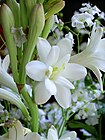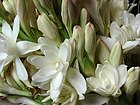Note: This is a project under development. The articles on this wiki are just being initiated and broadly incomplete. You can Help creating new pages.
Difference between revisions of "Polianthes tuberosa"
| Line 2: | Line 2: | ||
'''Polianthes tuberosa''' is a Bulb up to 1.00 metres tall. It is harvested from the wild for local use as a food and source of materials. | '''Polianthes tuberosa''' is a Bulb up to 1.00 metres tall. It is harvested from the wild for local use as a food and source of materials. | ||
==Uses== | ==Uses== | ||
| − | {{Uses|}}, {{Uses|}}, {{Uses|}}, {{Uses|}}, {{Uses| | + | {{Uses|Gonorrhea}}, {{Uses|Boils}}, {{Uses|Abscesses}}, {{Uses|Acne}}, {{Uses|Enlarged pores}}.<ref name="Uses"/> |
==Parts Used== | ==Parts Used== | ||
Latest revision as of 17:22, 7 July 2020
Polianthes tuberosa is a Bulb up to 1.00 metres tall. It is harvested from the wild for local use as a food and source of materials.
Contents
- 1 Uses
- 2 Parts Used
- 3 Chemical Composition
- 4 Common names
- 5 Properties
- 6 Habit
- 7 Identification
- 8 List of Ayurvedic medicine in which the herb is used
- 9 Where to get the saplings
- 10 Mode of Propagation
- 11 How to plant/cultivate
- 12 Commonly seen growing in areas
- 13 Photo Gallery
- 14 References
- 15 External Links
Uses
Gonorrhea, Boils, Abscesses, Acne, Enlarged pores.[1]
Parts Used
Chemical Composition
It contains main chemical components are menthyl benzoate, menthyl anthranilate, benzyl alcohol, butyric acid, eugenol, nerol, farnesol and geraniol etc.[2]
Common names
| Language | Common name |
|---|---|
| Kannada | Sukandaraji |
| Hindi | Rajanigandha |
| Malayalam | |
| Tamil | Nila Sampangi |
| Telugu | Nelasampengi |
| Marathi | Gulcheri |
| Gujarathi | |
| Punjabi | |
| Kashmiri | |
| Sanskrit | |
| English | Mexican tuberose |
Properties
Reference: Dravya - Substance, Rasa - Taste, Guna - Qualities, Veerya - Potency, Vipaka - Post-digesion effect, Karma - Pharmacological activity, Prabhava - Therepeutics.
Dravya
Rasa
Guna
Veerya
Vipaka
Karma
Prabhava
Habit
Identification
Leaf
| Kind | Shape | Feature |
|---|---|---|
Flower
| Type | Size | Color and composition | Stamen | More information |
|---|---|---|---|---|
| {{{5}}} |
Fruit
| Type | Size | Mass | Appearance | Seeds | More information |
|---|---|---|---|---|---|
Other features
List of Ayurvedic medicine in which the herb is used
Where to get the saplings
Mode of Propagation
How to plant/cultivate
Requires a warm sheltered position and a well-drained soil. When grown in pots it is best to use a fibrous loam enriched with compost and some silver sand for drainage.[5]
Commonly seen growing in areas
[[:Category:Herbs that are commonly seen in the region of |]], [[:Category:Herbs that are commonly seen in the region of |]], [[:Category:Herbs that are commonly seen in the region of |]], [[:Category:Herbs that are commonly seen in the region of |]], [[:Category:Herbs that are commonly seen in the region of |]].
Photo Gallery
References
- ↑ Indian Medicinal Plants by C.P.Khare
- ↑ Chemical constituents
- ↑ Common names
- ↑ [Morphology]
- ↑ Cultivation
External Links
- Ayurvedic Herbs known to be helpful to treat Gonorrhea
- Ayurvedic Herbs known to be helpful to treat Boils
- Ayurvedic Herbs known to be helpful to treat Abscesses
- Ayurvedic Herbs known to be helpful to treat Acne
- Ayurvedic Herbs known to be helpful to treat Enlarged pores
- Herbs with Flowers used in medicine
- Herbs with common name in Kannada
- Herbs with common name in Hindi
- Herbs with common name in Tamil
- Herbs with common name in Telugu
- Herbs with common name in Marathi
- Herbs with common name in English
- Habit - Bulb
- Index of Plants which can be propagated by Seeds
- Index of Plants which can be propagated by Division of offsets
- Herbs that are commonly seen in the region of
- Herbs
- Pages without herbs images




